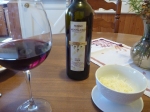When we started working on farms in the Hudson Valley a few years ago it became clear we could use a chest freezer to put by all our surplus food. Now we’ve reached a new level with our winter freezer contents, and as spring is coming around the corner we’re trying to use up as much as we can. Here’s the abbreviated list of what we’ve got left: various blends and molds of pesto, whole chickens, salmon, meat, fruits, greens, a few herbs, tomato sauce, beans, tomatoes, peppers, and many other veggies.
So, we roasted a chicken following Julia Child’s instructions, but the picture is a good use of the leftovers: shredded leftover chicken with couscous, peppers, olives, raisins, and a shallot and lime vinaigrette with butter glazed carrots.
We also got a first use out of grandma Celeste’s copy of Marcella Hazan’s classic, Essentials of Classic Italian Cooking, and modified one of her sausage and pasta recipes. The pasta we used was from Mario Batali’s Eataly shop in NYC, and it was called calamari because, maybe I’m stating the obvious, it’s shaped like calamari.
The caveman-like dish was actually a braised lamb shank paired with a great Rosso di Montalcino. In a Dutch oven we braised the shanks in red wine with some aromatic veggies and after a few hours, voila. The Rosso was a great table wine and really paired well with the food. Although Emma sells wine for a living I can at least say this: the wine was well-balanced, smelled of dark fruits, dried cherries or raisins (maybe even a bit of leather), was dry but pleasant to drink with some acidity and a lingering finish. Oh, I almost forgot (probably due to the wine) that the pasta dish was a primi to the lamb, so the Italian wine went well with the Italian dish as well as the lamb. On the side, we roasted parsnips.
And of course we had apple pie for dessert! Emma made the beautiful lattice top, but since it’s hard to level the apples the fruit ended up sinking away from the lattice after baking–ah the details. Nonetheless, we’ve been getting excellent apples at the public market, and for this one we used Matzu/Crispin and Ida Red.













